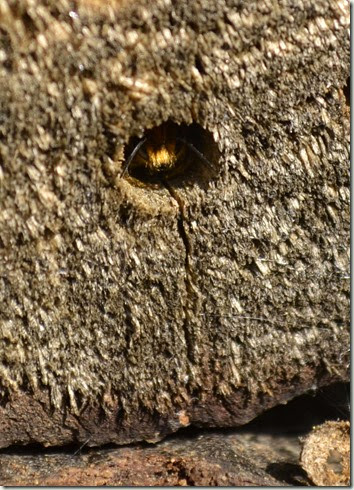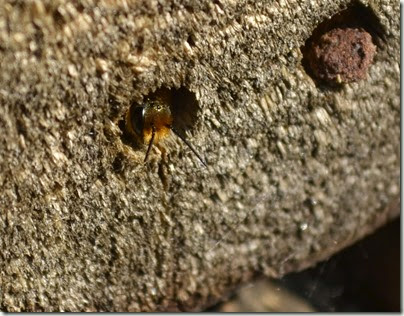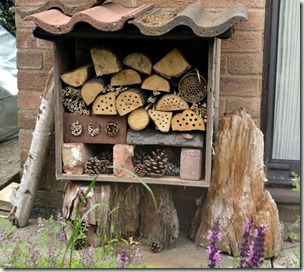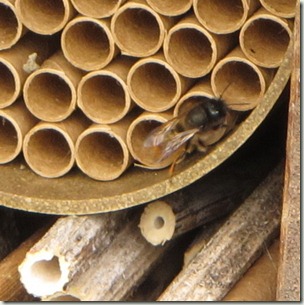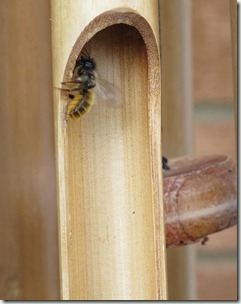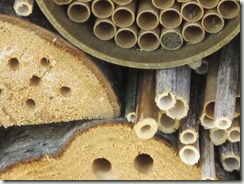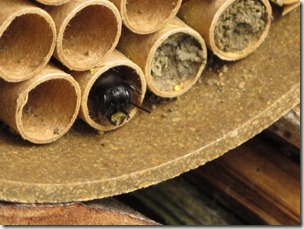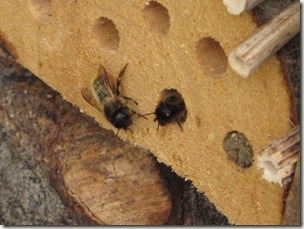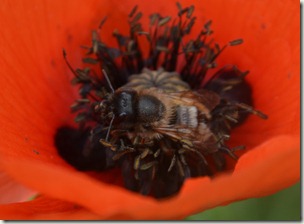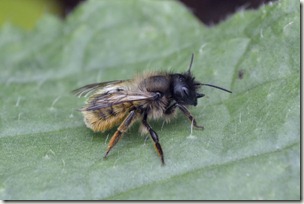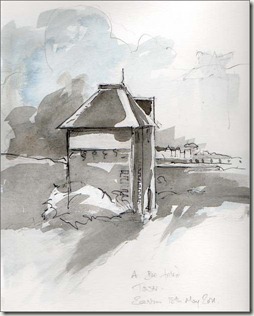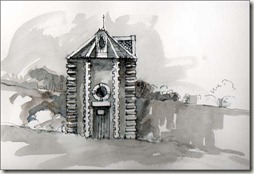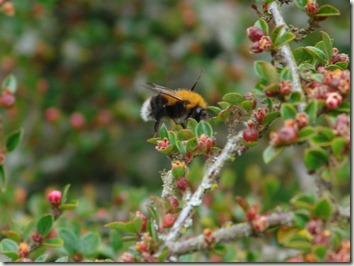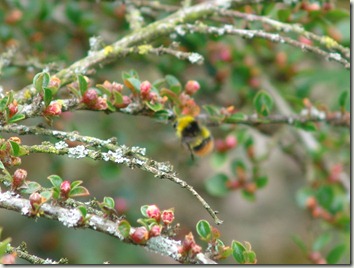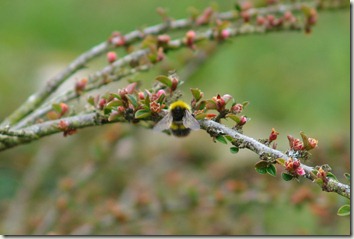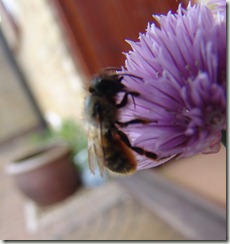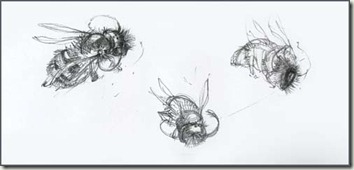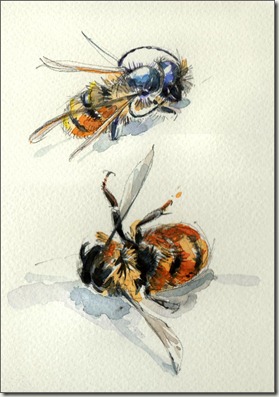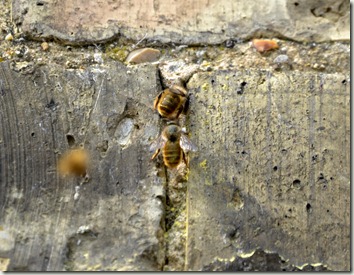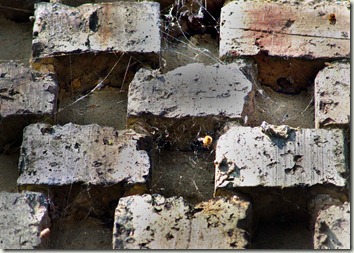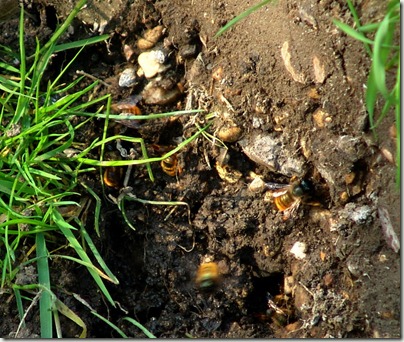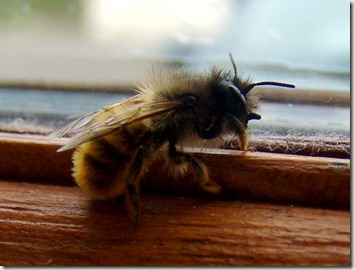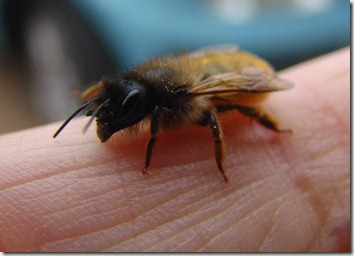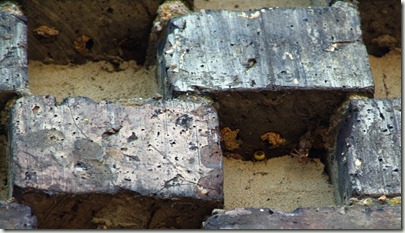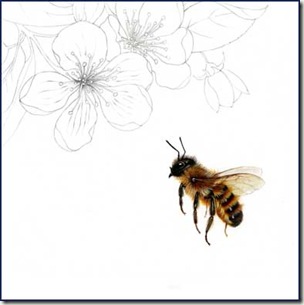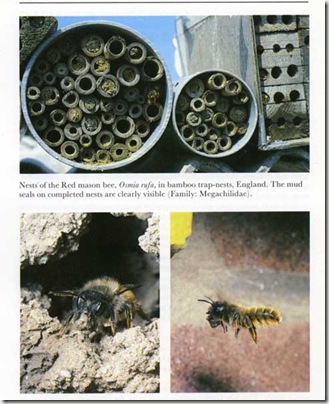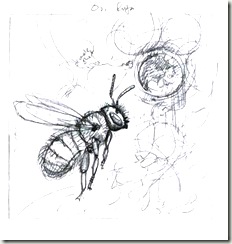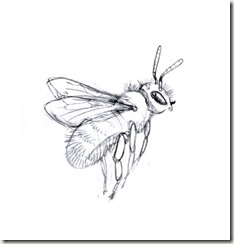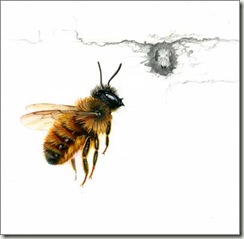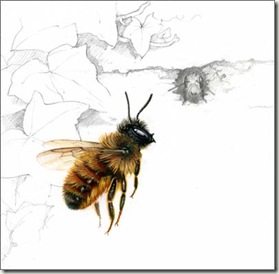I think the little colony of mason bees who have given us so much pleasure over the last couple of months are getting towards the end of their allotted span. I find myself feeling sad because they have been such a delight and we have become very fond of ”The Girls” Here are a few notes detailing their time with us.
A Brief Diary of the Mason bees

I was late getting my bee house assembled. Its frame was appropriately an old frame from Dad’s beehive with drilled logs, hollow plant stems, a ready made bee house and all mod cons.
I wondered if any bees would even find it, never mind make a nest there.
So, back in March I was ridiculously excited to find a female mason bee exploring the twigs and a hopeful male hanging around too.
March 20th: First investigations
. 
Following glorious warm weather a glossy bright and new female checked out the hollow stems

and a hopeful male arrived.
APRIL
But nothing much seemed to happen in April. There were no takers for my bee house. It was so wet and so cold. I wondered if all the bees had died. But gradually with the help of a few sunny days I began to see more and more of them flying.
The males and females will mate and then sadly the males die. It’s a very short life for them, but for the females things are just getting busy.
They investigated every inch of the house and surrounding walls, every knot hole in the fence, every nail hole and crack in the mortar and even the definitely-too-large wind chime tubes.
Watching them choose their homes was fascinating. They went in and out of all the cardboard tubes and the holes I had drilled.
They even squeezed into much-too-tight ones and they tried some of the hollow plant stems.
But I was surprised to find that they were not only picky, but rather modern in their choices.. rejecting the rustic and twiggy natural homes, preferring the modern prefabricated regular and clean cardboard tubes..or is it that they are closer together and can maybe hear each other, perhaps they pass on information or just generate some extra heat creating a warm, welcoming and safe little colony.
Who knows what goes on in those little bee brains?

The wind chimes hang outside the kitchen window and on 25th May I heard a very loud resonating buzzing.
Thinking it was a bee caught in a web or in some sort of distress I looked everywhere. But it was a Mason bee trying out a windchime for size. It persisted for about 3 days, returning exploring,
weighing up the pros and cons and presumably enjoying the vibe!

MAY
Then hurahhh… back in the bee house on the 25th May one nest was completed, a time to celebrate!

On the 26th two..

Mason bees need mud to construct their nests and in a north facing corner of the garden we have a dank miserable patch of earth which I call Death Valley. Nothing grows there. It is always damp and always in shade, but I have learnt over the past few months that almost everything has its uses and it proved to be the Girls’ favourite mud-gathering quarry.
And not only my little colony but Mason bees came from all around.
At the height of nest building activity about a month ago I counted 25 bees busily running around and collecting little balls of building clay for walling up their nest cells.

They gather up balls of mud in their strong jaws and carry it back to the nest. The ground is alive and buzzing! If you were to stumble upon this activity by accident you might well be alarmed…but the gentle Mason bees only have nest building on their minds!
JUNE
They got off to a good start in May and we counted 9 tubes filled.. then everything stopped at the beginning of June. There was no activity for days and again I wondered if they had died…but on a sunny day they started to reappear.
19th June

Slowly little black horned faces and twitching antennae came to the entrances of the tubes. They shelter in the empty holes..some even using my nicely drilled logs!

They waited until the sun warmed them up and sometimes seemed to confer before flying off to resume collecting pollen, nectar and mud.
 T
T
here was a rush of activity in the few sunny days we had, they returned to Death Valley to collect mud and sealed up at least 15 more holes. Since then the weather has been off and on and I have been busy. Sometimes I would pop out to see how they were doing. Little black faces sometimes yellow with pollen peered out from holes and occasionally one would emerge and wait for the sun before flying off. But activity has been declining.
27th June, Today
Today was warm and there is still some activity but perhaps only a couple of bees are left. To date they have completed or partly completed 35 cardboard tubes, one drilled hole in the log and one plant stem. But the remaining girls are looking a little shabby, a little bald and definitely faded. They are a little lack lustre and quiet.

One unexpectedly revelled in the pollen rich stamens of an early morning poppy. The other stopped to rest on a sunny borage leaf.

She stayed on the leaf for about 15 minutes. A good opportunity to immortalise this hard working bee. You can see quite clearly one of her strange little horns.

This evening just one bee was digging…

And here are my last two girls…at 7.00pm, doing what they do so beautifully and doing what gives them their name.
These are the Mason Bees… they build… they do not destroy!

At 7.30 pm they had finished. Their newly completed tubes are dark and still wet. They may not be the prettiest of bees but we have become extremely fond of them. They are as wild as a wild thing can be but we look out for them.
I don’t know how long they will continue before they just run out of steam.
With the turn of the year they are on the wane. In their carefully provisioned and sealed nest cells their grubs will spin cocoons and become tiny adult bees and wait.
They will wait until the winter is over.
Wait for a beautiful spring day next year to start a new generation of delightful Osmia rufas, the gorgeous and adorable red mason bees. See you then little ones 🙂

